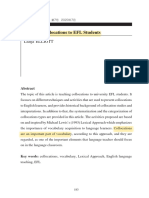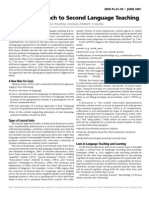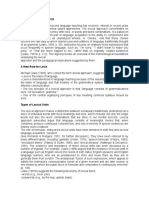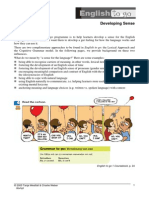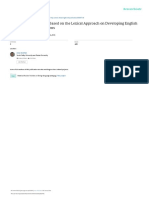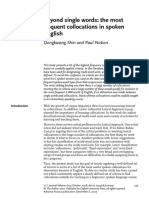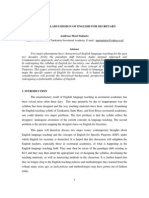0 ratings0% found this document useful (0 votes)
23 views07 Chapter 1
economics
Uploaded by
josewojCopyright
© © All Rights Reserved
Available Formats
Download as PDF, TXT or read online on Scribd
0 ratings0% found this document useful (0 votes)
23 views07 Chapter 1
economics
Uploaded by
josewojCopyright
© © All Rights Reserved
Available Formats
Download as PDF, TXT or read online on Scribd
You are on page 1/ 27
8
THE LEXICAL APPROACH
1.1. Overview
This chapter provides a detailed introduction to the theoretical
background of the lexical approach. It lists out the principles of this
approach as advocated by Lewis and provides a brief description of each
of them. The chapter explains the term lexis and emphasises the role of
lexis in language. It further highlights the importance of this approach in
language teaching and learning. It also outlines five different frame
works used in the categorization of lexical chunks as propounded by the
advocates of this approach. The chapter also presents the limitations of
the lexical approach. Finally, the chapter enumerates the benefits of
using comics in teaching and learning a language.
1.2. Introduction to the Lexical Approach
A few decades ago, there was a predominant view in the linguistic
circles that vocabulary was subservient to grammar. Linguists at that
time strongly supported the dichotomy of grammar and vocabulary and
they preferred to lay emphasis on the structures of language rather than
the words. Also, they were of the view that acquisition of a language is
dependent on the mastery of grammatical rules of the language and
vocabulary is of secondary importance.
But during the 1990s there was an increased interest in
vocabulary teaching and learning. The book Teaching and Learning
Vocabulary (1990) by Paul Nation provided useful insights into
vocabulary acquisition and it extended guidance on classroom
pedagogy. At the same time, the advent of corpus linguistics and the
COBUILD project of John Sinclair (1987) gave new impetus to theories
9
on language acquisition. Sinclairs book Corpus, Concordance,
Collocation (1991) and other corpus based studies shed new light on
how language works and this led to a new understanding and description
of language. Also, these studies revealed the widespread occurrence of
multi-word units or lexical chunks in native speakers language. The
studies then put forward a theory that is almost contrary to Chomskyan
theory of language which holds that native speakers have a capacity of
creating and interpreting unique sentences which they have never heard
or produced previously. Moreover, Chomskyan theory believed that:
linguistic competence consists solely in the
ability to deploy an innate rule- governed
sentence-making capacity.(Thornbury, 1998:8)
But with the advent of corpus based analyses, many linguists
departed from the Chomskyan view to uphold the new theory of
language.
With the publication of the book The Lexical Approach: The
State of ELT and a Way Forward in 1993, there was a shift from the
traditional approaches to a lexis based approach which holds that:
the building blocks of language learning and
communication are not grammar, function,
notions, or some other unit of planning and
teaching but lexis, that is, word and word
combinations.
(Richards & Rodgers 2001:132)
To quote Lewis, this approach focusses on developing learners
proficiency with lexis, or word and word combinations.(1993:95).
He substantiates this view in the book Implementing the Lexical
Approach: Putting theory into Practice, and states :
10
Fluency is based on acquisition of a large
store of fixed and semi-fixed prefabricated
items, which are available as the foundation
for any linguistic novelty or creativity.
(1997:15)
He holds that native speakers store chunks in their mental lexicon
to retrieve and use them in their language. Also, he states that the ability
to chunk language successfully is central to an understanding of how
language works.
For this reason, Lewis suggests that language teaching should
include the teaching of lexical phrases or chunks. In fact, he advocates
that lexical phrases in any language offer more communicative and
expressive power than grammatical structures. He further stresses that
without chunking acquisition, comprehension and production of the
language will be limited and slowed down. Thornbury substantiates this
view and holds that chunking serves two purposes at early stages of
language learning:
It enables language learners to have chunks of the language available
for immediate use.
It also provides the learner with data to hold in reserve for
subsequent analysis. (1998:8)
1.3. Principles of the Lexical Approach
Though this approach became popular in the1990s, there are
many researchers who are not clear of the principles of this approach
and how it is practised. It is apt here to list out the principles as
enumerated by Lewis (1993:vi-vii) which most advocates of lexical
approaches adhere to. It would also be apt here to examine all these
principles in detail :
11
1. Language consists of grammaticalised lexis, not lexicalised grammar
The main tenet of lexical approach is its emphasis on lexis.
According to Lewis language is made of lexical elements besides
grammar. He feels that emphasis should be laid on structures made of
word, clusters of words or lexical chunks rather than grammatical
structures. Substantiating this view Thornbury writes :
Lewis challenges the traditional view that
language competence consists of having a
foundation of grammatical structures into
which we slot individual words. Instead, we
store a huge assortment of memorised words,
phrases and collocations, along with their
associated grammar. The approach
concentrates on developing learners
proficiency with lexis, or words and word
combinations. (2002:114)
2. The grammar/vocabulary dichotomy is invalid: much language
consists of multi-word chunks:
Lewis is of the view that vocabulary cannot be differentiated from
grammar. Nattinger and De Carrico consider a lexical phrase or a chunk
as a lexico-grammatical unit which exists somewhere between the
traditional poles of lexicon and syntax (1992:36). Lewis advocates that
every word has its own grammar and it is not suggestable to create a
distinction between vocabulary and grammar. Instead of viewing
language as simply words and grammar, he suggests that language be
viewed as consisting of multi-word chunks. He states that language
acquisition is faster when it is learnt in chunks rather than in isolated
individual words.
12
3. A central element of language teaching is raising students awareness
of, and developing their ability to chunk language successfully :
Lewis holds that noticing lexical chunks in the language is a
prerequisite for learning language. He argues that increased awareness
helps in converting input to intake. Added to consciousness-raising, he
feels that importance should be given to developing in learner the ability
to chunk the language. According to him:
the central idea to efficient acquisition and
effective communication is chunking. Unless
you chunk a text correctly, it is almost
impossible to read with understanding, and
unless you speak appropriate chunks, you
place a serious barrier to understanding
between yourself and your listeners. (Lewis
1997:58)
4. Collocation is integrated as an organising principle within
syllabuses:
Collocation is central to the lexical approach because the way
words combine in collocations is fundamental to all language use. Lewis
stresses on the importance of learning the patterns of collocations
because much of the spoken and written language comprises them. Hill
says that we need to add the concept of collocational competence to our
thinking as it aids us in avoiding errors in our language. Thus,
proficiency in a language is greater when there is a focus on collocations
(2000:48). As Oxford Collocations Dictionary puts it :
No piece of natural spoken or written English
is totally free of collocation. For the student,
choosing the right collocation will make his
speech and writing sound much more natural,
13
more native speaker-like, even when basic
intelligibility does not seem to be at issue. A
student who talks about strong rain may
make himself understood, but possibly not
without provoking a smile or a correction,
which may or may not matter. He will
certainly be marked down for it in an exam.
(2009:V)
5. Evidence from computational linguistics and discourse analysis
influences syllabus content and sequence:
Advances in computer-based studies of language, such as corpus
linguistics have provided huge databases of language corpora. In
particular, COBUILD project provided an accurate description of
English language and laid a foundation for lexical syllabus. Willis&
Willis (1989) made an attempt to develop a syllabus based on lexical
rather than grammatical principles. Willis syllabus specifies the usage
of words, their meanings and patterns of the common phrases in their
most natural environments. Unlike Williss, Lewiss lexical syllabus
recognises word patterns for de-lexical words,
collocation power for semantically powerful
words, and longer multi-word items, partially
institutionalized sentences, as requiring
different and parallel pedagogical treatment.
(1993:109)
6. Language is recognized as a personal resource, not an abstract
idealisation:
In the lexical framework, language is perceived as a personal
resource rather than as an abstract idealisation. By extension, learning a
language enables a learner to become resourceful in using it.
14
7. Successful language is a wiser concept than accurate language:
Like the other communicative approaches, which stress on
communicative proficiency, the lexical approach too highlights the
importance of successful communication rather than the production of
accurate language. It believes that acquisition of lexical chunks makes a
learners communication more effective.
8. The primacy of speech over writing is recognized; writing is
acknowledged as a secondary encodement, with a radically different
grammar from that of the spoken language:
Contrary to the traditional approaches which advocated the
primacy of writing over speech, the lexical approach believes that the
learners at first should speak fluently in the language before they could
learn writing. Lewis feels that any learner can acquire a language if
he/she tries to emulate the ways adopted by a native speaker.
9. It is the co-textual rather than situational elements of context which
are of primary importance for language teaching :
Lewis feels that co-textual elements of language are more
important for language learning than contextual elements. While
contextual elements aid the learner in comprehending the situation of
utterance and the situation of occurrence of the speech, co-textual
elements help in knowing the discourse preceding and following a
particular word. He further states that the awareness of the co-textual
elements makes us understand the co-occurrence of various words
which in turn leads to effective learning.
15
10. Socio-linguistic competence-communicative power-precedes and is
the basis, not the product, of grammatical competence :
Lexical approach recognises the importance of socio-linguistic
competence and communicative power in attaining mastery of a
language. It advocates that the ability to use a language and the ability to
respond to the language appropriately in a social setting are the bases to
achieve grammatical competence in a language and not vice versa.
11. Grammar as structure is subordinate to lexis :
The lexical approach rejects the notion that grammar is superior
to lexis. The advocates of this approach believe that:
Language is primarily lexical and grammar is
largely an illusion created by different models
of language. (Rani 2009:162)
This approach argues for bringing lexis to forefront while learning
a language and it emphasises teaching of lexis rather than grammar or
individual words. Lewis substantiates this view when he says:
Language consists not of traditional grammar
and vocabulary but often of multi-word
prefabricated chunks. (Lewis1997:3)
He strongly argues that every word has its own grammar and
holds that if a lexical item is learnt, the grammar of it is also implicitly
learnt without much emphasis. For example : Eat a chocolate. The
encounter of the word eat makes the learner notice that it is in its
present tense. He holds that grammar is inbuilt in lexical items. This
thesis focuses mainly on learning language through lexical chunks.
Since a number of studies already exist on the teaching of grammar, the
16
present study has explored only teaching of lexis. References to
grammar are made only wherever found relevant.
12. Grammatical error is recognised as intrinsic to the learning
process:
Lewis is of the view that any learner is prone to make
grammatical mistakes while learning a language. Production of
erroneous sentences according to him is a part of leaning. Unlike
traditional approaches which do not encourage the production of
incorrect language, the lexical approach welcomes mistakes in speech
and considers them as intrinsic to the process of learning.
13. Grammar as a receptive skill, involving the perception of similarity
and difference, is prioritised :
Grammar is not a productive skill as is purported to be in
structuralist descriptions of language. It cannot be acquired through
mere mechanical drilling of structures. The perception of similarity and
difference in the way grammar works is seen as more important in the
lexical approach.
14. Sub-sentential and supra-sentential grammatical ideas are given
greater emphasis, at the expense of earlier concentration on sentence
grammar and the verb phrase :
The lexical approach involves an increased role of word grammar
(sub-sequential grammar) and text grammar (supra-sentential grammar).
It holds that the word grammar and word partnerships are more
important while acquiring a language than sentence grammar. At the
same time it attaches significance to text grammar and discourse
markers in the process of learning a language.
17
15. Task and process, rather than exercise and product, are
emphasised:
As in task-based, procedural syllabuses of Communicative
Language Learning, the lexical approach also underscores the
importance of the process of learning rather than its product.
16. Receptive skills, particularly listening, are given enhanced status:
Lexical approach believes that production of a language is based
on its reception. It further states that the amount of exposure to a
language determines the production of a language. So, it stresses on the
need to enhance the listening skills of the learners which play a pivotal
role in language acquisition.
17. The Present-Practise-Produce paradigm is rejected, in favour of a
paradigm based on the Observe-Hypothesise-Experiment cycle:
The approach rejects the Present-Practise- Produce paradigm as it
is similar to the rote repetition of a language. It is more of a teacher-
centred paradigm where the teacher presents the information to be
learnt, makes the learners practise it and finally makes the students
produce it without much of their involvement. But the Observe-
Hypothesise-Experiment cycle makes the learners engross themselves in
the activities assigned to them. They are provided a chance of probing
into the language and making predictions and also experiment on it in
their own way. This paradigm grants them considerable freedom to
apply their knowledge in the process of acquiring a language.
18. Recycling and reviewing the language taught:
Lexical Approach adopts the strategy of recycling and reviewing
to teach the language. Lewis believes that learners should be first taught
18
to recognize and produce the chunks of language. He says that they
should be given chances to revise what has been learnt before. Then,
through repetition, he thinks learners will be able to produce them
eventually with some automaticity, thereby improving fluency. As,
Lewis (1997: 45) states recycling should be done in an interesting and
refreshing way, so that learners interest is still engaged. Following
these points, the study has made every attempt to make a revision of the
chunks the learners are introduced to. Activities and exercises are
devised in such a way that they create interest in the learners.
1.4. Lexis
Though the terms lexis and vocabulary are often stated in the
same context and mostly treated as synonyms, there exists a difference
in meaning between these two terms and they are not one and the same.
The distinction will be made clear by making a note of these definitions
put forward by two advocates:
The entire store of lexical items in a language is called its lexis.
(Wikipedia)
Lexis refers to strings of words which go together.
(Lewis 1997:213)
Lexis is a more general word than common
vocabulary. Vocabulary is often used to talk of
the individual words of language; lexis covers
single words and multi-word objects which
have the same status in the language as simple
words, the items we store in our mental
lexicons ready for use.
(Lewis1997:217)
Lexis includes not only the single words but
also the word combinations that people store
in their mental lexicons. (Olga 2001:1)
19
Different scholars have referred to these multi-worded units by
different terms :
Holophrases (Corder1973)
Prefabricated patterns(Hakuta 1974)
Gambits (Keler 1979)
Speech formulae(Peters 1983)
Lexicalized stems( Pawley and Syder 1983)
Lexical phrases(Nattinger & Decarrico 1992)
Multi-worded items(Lewis 1993)
Lexical items/chunks (Lewis 1997)
Prefabricated chunks (Williams 1998)
1.5. The Role of Lexis
Wilkins, a supporter of the lexical approach, was the first to stress
the importance of the role of vocabulary in language teaching. He stated
without grammar very little can be conveyed; without vocabulary
nothing can be conveyed (1992:11). Sinclair (1995) also agrees with
Wilkins view and points out : A lexical mistake often causes
misunderstanding, while a grammar mistake rarely does (cited in Lewis,
1997:16)
In his advocacy of a new role for lexis, Lewis (1993) proposed the
following major ideas:
1. Lexis is the basis of language.
2. Lexis is misunderstood in language teaching because of the
assumption that grammar is the basis of language and that mastery
of grammatical system is a prerequisite for effective communication.
20
3. One of the central organising principles of any-meaning-centred
syllabus should be lexis.
4. The key principle of a lexical approach is that language consists of
grammaticaliazed lexis, not lexicalised grammar.
(cited in Olga 2000:1)
1.6 Lexical Approach in Language Teaching
It is clear that in a lexical approach, lexis plays an important role
in language teaching and learning. Nattinger says that teaching should
be based on the idea that language production is the piecing together of
ready-made units appropriate for particular situation (1980:34). So, the
understanding of such units is dependent on knowing the predictable
patterns in different situations. Lewis holds that implementing lexical
approach in the class room would entail teachers paying more attention
to :
Lexis of different kinds
Specific language areas
Listening (at lower levels) and reading(at higher levels)
Organising learners notebooks to reveal patterns
The language learners may meet outside the classroom (songs,
films, books, Internet)
Preparing learners to use text for their benefit
Preparing learners to chunk the language
Creating a habit of using dictionaries as learning sources
(1997:15)
21
1.7 Lexical Approach in Language learning
In the lexical approach, lexis in its various types is thought to play
a central role in language learning. The lexical approach recommends
the learning of multi-word items as they aid the learner in producing the
language without much effort. To quote Lewis:
Lexis helps us to handle highly probable
events fluently and effortlessly by providing us
with prefabricated ways of dealing with them.
(1977:41)
But at the same time Lewis emphasises that the lexical approach
does not undermine the importance of grammar. As he puts it,
The Approach in no way denies the value of
grammar, nor its unique role in language.
(Lewis: 1977: 41)
According to Lewis students should also follow a few things
while practising this approach in learning a language:
Concentrating on what words mean and how words are used
Participating by listening to the language, noticing and reflecting
Learning to chunk the language
Maintaining lexical notebooks to record selected chunks of the
language
Doing the exercises and activities designed in the text
Using dictionaries as learning resources.
(1997:58)
22
1.8. Lexical Categories
The lexicalists classify lexical items into different categories
using different terminology. At least five different classifications could
be identified and a detailed examination of these five classifications is
provided below:
1.8.1 Pawley and Syders Classification
Pawley and Syder were first to divide lexical chunks into two
types:
1. Memorized sentences
2. Lexicalized stems
According to them, Memorized Sentences are not capable of
expansion and are spoken as they are. For example, Can I come in?,
Theres no pleasing some people.
The second category in their opinion is capable of expansion and
substitution unlike memorized sentences. Ex: Tell the truth/Tom seldom
tells the truth.
1.8.2 Nattinger & Decarricos Division
1. Lexical Phrases
2. Institutionalised Phrases
3. Phrasal Constraints
4. Sentence Builders
The division places Lexical phrases as they call, into four
categories which is lengthier than the previous one. The first of this
division is Polywords. These are short phrases which function very
much like individual lexical items (1992:38). Ex: for the most part, in a
nutshell.
23
The second one they call Institutionalised Phrases. These are
lexical phrases of sentence length, usually functioning as separate
utterances e.g: How do you? , There you go, Long time no see.
(1992:39).
The third one is Phrasal Constraints. By this, they mean short - to
medium- length phrases associated with a wide variety of functions.
Ex: a ________ ago, See you______ (1992:41)
The fourth category is Sentence builders which they say are
lexical phrases that provide the frame work for whole sentences. e.g: I
think (that) X__________, My point is that _________.(1992:42)
1.8.3 Moons Classification
Moon (1997) includes five categories of multi-word items
1. Compounds
2. Phrasal verbs
3. Idioms
4. Fixed Phrases
5. Prefabs
According to her, the first division Compounds is the largest and
most tangible group. In this category, it is possible to see the movement
of language at work, for example in the case of Car Park--- the words
are slowly being pushed together to form a compound: Car park, Car-
Park, Carpark.
The second category she suggests is Phrasal Verbs. They are
combinations of verbs and particles: bring out, head off.
24
The third division is Idioms which are multi-word items: To quote
Moon, they have holistic meanings which cannot be retrieved from the
individual meanings of the component words. For ex: Spill the beans
(1997: 46),
The fourth one is Fixed Phrases. These are grammatical and
discourse items. E.g. Of course, at least, by far. Also similies: White as
a sheet and
Greetings: How do you do ?
The fifth category is what she calls Prefabs. Moon states
these are pre-constructed phrases,
phraseological chunks, stereotyped
collocations,, or semi-fixed strings which are
tied to discoursal functions and which form
structuring devises. (1997:47)
1.8.4 Williamss Division of Lexical Categories
Unlike Nattinger and Moons classification, Williams describes
the prefabricated language as comprising three types of chunks :
1. Functional Stems
2. Purely lexical chunks
3. Semi-lexical chunks
Williams defines Functional stems, as recognisable components
of what are presented as functional exponents in published materials.
e.g: I dont think and Can I just (1998:48)
Williams describes Purely Lexical Chunks as fully lexical items
which are of little interest because they are linked to a specific context.
e.g. the new system (1998:51)
25
The third division Semi-lexical chunks according to Williams :
is the traditional division of lexis into content
and function words is over-simplistic. Many
lexical items are delexicalized or semi-lexical
and find their reference and meaning in their
context. E.g. in terms of , on the basis, on the
basis of (1998 :54)
1.8.5 Lewiss Division of Lexical Chunks
Though there are different types of classifications of the chunks,
this study adopts the division postulated by Lewis.
Lewis (1997:8) identifies multi-word items as falling into four
types:
1) a) Words
b) Polywords
2) Collocations
3) Fixed Expressions
4) Semi-Fixed Expressions
1.8.5.1 Words and Polywords
The first category is sub-divided into Words and Polywords. The
former is a familiar one and refers to what we traditionally call
vocabulary. It constitutes the largest of all the four categories. The
lexical approach also recognizes individual words as a part of lexis but
it holds that there are several types of lexical items of which individual
words are one type. Lewis states that words which can stand alone
(OPEN, CERTAINLY!) are lexical items, as are words where a single
substitution produces a totally new meaning: salt/pepper in could you
pass the _______ please ? (1997:8)
26
The next sub-category Polywords is a small group of lexical items
which falls between words and major multi-word categories. These
chunks are normally not reversible. For eg: bread and butter. Lewis
considers adverbial phrases of different kinds as polywords. To quote
him
they are nearly always very short 2- or 3-
word phrases which are obvious units. They
are often, but by no means exclusively,
adverbial phrases of different kinds.
Lewis (1997:8)
Here are some examples:
Sentence adverbs: on the other hand, in some ways
Expressions of time: the day after tomorrow, every now and then
Prepositions of place: on either side of, upside down
Lewis (1993:92) treats phrasal verbs as one kind of polywords and
this he feels the only one to be featured prominently in conventional
language teaching. e.g: put off, look up, look up to
1.8.5.2 Collocations
The second major category of lexical items is collocations. These
are chunks of lexical items that naturally co-occur by mutual
expectancy. The following definitions offer varied views on the concept
of collocation:
You shall know a word by the company it keeps. (Firth 1957: 179)
We may use the term node to refer to an item whose collocations
we are studying, and we may define a span as the number of lexical
items on each side of a node that we consider relevant to that node.
Items in the environment set by the span we will call collocates.
(Sinclair 1966:415)
27
The study of lexical patterns. (Brown 1974:1)
A sequence of words that occurs more than once in identical form and
which it commonly associates. (Kjellmer 1987:133)
Collocations describe specific lexical items and the frequency with
which these items occur with other lexical items. A collocational
unit consists of a node that co-occurs with a span of words on either
side.
(Nattinger & De Carrico 1992: 20)
A recurrent co-occurrence of words. (Clear 1993: 277)
The way individual words co-occur with others. (Lewis 1993:93)
The readily observable phenomenon whether certain words co-occur in
natural text with greater than random frequency (Lewis, 1997:8)
A collocation is a predictable combination of words (Hill, 2000:51)
Collocations are common combinations of words (Lewis 2000:127)
It is interesting to note that like polywords which are mostly
irreversible in their usage, collocations too are not normally
interchangeable. For example: make a mistake and do the work. Though
make and do are considered near synonyms, they cannot be used
interchangeably. In a collocation, a node is the main word referred to
and collocate is the word which co-occurs with the node. For example ;
scrambled egg. Here, egg is the node and scrambled is its collocate.
Other words like boiled, fried, soft-boiled can be the collocates of the
node egg.
Hill (2000:63) finds collocations falling into four types:
1. Unique Collocations : e.g. foot the hill
2. Strong Collocations : e.g moved to tears
28
3. Weak Collocations : e.g a good weekend
4. Medium Collocations : e.g do the laundry
Noting the importance of teaching collocations, Jimmie Hill
points out :
In the same way that we teach individual
words- vocabulary- we need to teach
collocations there is no point in knowing the
meaning of the words unless you also know
the collocation. (Jimmie Hill, 2000:60)
Lewis (2000:51) suggests that teachers should draw learners
attention to collocations of different kinds.
Adjective + Noun magnificent bird
Noun+ Noun talent show
Verb+ Adjective+ Noun revise the original plan
Verb+ Adverb recover immediately
Adverb+ Verb well rewarded
Adverb+ Adjective totally safe
Verb+ preposition + Noun seething with anger
1.8.5.3 Fixed Expressions
The third division of items is Fixed Expressions which is also
known as Institutionalized Expressions. Lewis states:
these are comparatively rare and short. These
are chunks a speaker stores as units and uses
in speech. (1997:9)
29
Lewis feels that language teaching has always recognized some
types of fixed expressions. The most frequent examples that have
featured in teaching materials:
Social Greetings: Good morning; How are you ?
Politeness Phrases: No thank you, Im fine.
Phrase Book Language: Can you tell me the way to. Please?
Idioms: Hang on, youre putting the cart before the horse there.
Lewis suggests that fixed expressions should be taught without
internal analysis and students should be introduced to the idea that such
expressions exist in their own language too.
1.8.5.4 Semi- Fixed Expressions
The last category is Semi-fixed Expressions. This category
according to Lewis is an important one that contains a spectrum.
These expressions range from very long and from almost fixed to very
free. He also states:
these are often verbless expressions in the
spoken language for managing everyday
situations (Lewis,1997:11)
Lewis categorizes fixed expressions into various types:
Almost fixed expressions, which permit minimal variation: Its /
Thats not my fault
Spoken sentences with a simple slot: Could you pass.. please ?
Expressions with a slot which must be filled with a particular kind of
slot-filler: Hello. Nice to see you. I havent seen you + time
expression with for or since.
30
Sentence heads, which can be completed in many ways: What was
really interesting /surprising/annoying was..
More extended frames such as those for a formal letter or the
opening paragraph of an academic paper. For example: These are
broadly speaking two views of..The more traditional, usually
associated with(Lewis,1997:11)
Though there have been different categorizations of the chunks,
this study adopts Lewiss categorization of lexical chunks.
1.9 Limitations of the Lexical Approach
Like many approaches, this approach also has many short-
comings. Firstly, many linguists deny lexical approach as an approach
for the reason that it does not provide any coherent theory of language
or language learning. As Thornbury puts it:
Lexical Approach is not an approach, not in
the strict sense, since it lacks a coherent
theory of learning and its theory of language
is not fully enough elaborated to allow for
ready implementation in terms of syllabus
specification. (Thornbury, 1998:12)
Secondly, though Lewis has a theory about the nature of
language, Language consists of grammaticalised lexis, not lexicalised
grammar. (1993: vi) Lewis does not specify the sort of syllabus he
favours. Also, he recommends the use of language material which is
text-based and discourse-based, but he does not specify the selection and
organisation of such texts and discourses.
31
Thirdly, Lewis emphasizes on noticing and memorization of the
chunks of language. But, he offers no clear guidelines as to the selection
and grading of the chunks.
Moreover, Lewis assumes that it is the exposure to language and
not formal teaching that can increase the learners lexicon. But, this
raises the doubt if the teaching ideas included in Lewiss books are
redundant.
Though the adoption of this approach in language classrooms may
not lead to methodical changes, it might change the teachers and
learners mind set. So, to implement this approach, there should be a
rationale and design for lexically based language teaching. More so, a
focus on lexical syllabus should be made to concentrate much on
language use.
The main criticism levelled against the lexical approach is that it
makes no suggestions about how the principles of this approach can be
translated into a syllabus. Though Williss book The Lexical Syllabus
does suggest some guidelines they are not found to be practically useful.
Except for McCarthys books on Collocations in Use, Phrasal
Verbs in Use, Idioms in Use, there are not any significant text cum work
books on lexical items in use. There are no such books/materials at all
on lexical items written by Indian authors. The present project is a
modest step towards filling that gap by attempting to prepare a kind of
work book on different lexical items collected from thirty different
comics.
32
1.10 Role of Comics in Teaching/Learning Lexis
Lexical Approach believes in the principle that language should
be taught through authentic texts. As Lewis puts it :
The single most distinctive feature of the
lexical approach is that it proposes a
fundamentally different attitude to the
treatment of text.It recognises the
importance of co-text and therefore prefers
text or discourse in language teaching.
(Lewis1997:106)
Texts not only provide the learners with interesting content, but
also supplement the learners with many lexical items. Since the study
adopts the framework of lexical approach, it has chosen comics, which
are also authentic texts.
Besides, the research has found that comics are a rich source of all
the lexical categories identified in the lexical approach.
1.10.1 Advantages of using comics in Language Learning/Teaching
There are several benefits in incorporating comics into language
teaching :
They contain natural, conversational English that is
comprehensible.
They have a visual appeal on the readers.
Learners try to predict, deduce and infer from the pictures in the
comics.
They project the culture of the place they represent.
They can be read quickly with no strenuous effort.
33
They can, to a great extent, evoke humour in the learners.
They can be highly effective in breaking the monotony that crops
up during the process of language learning /teaching.
They narrate stories which are very easy to follow.
They provide us an excellent opportunity for exposure to
authentic language.
They can, to a considerable extent, relieve us from our tensions.
Taska substantiates the afore said points and notes that
the delightful thing about some of the comic
strips is that while they appeal to learners of
all ages and backgrounds, they also furnish
language material that is culturally based and
pedagogically useful. (Taska 1979:373)
He further notes the advantages of comics in this way:
They are short and complete enough to be
read and understood quickly. The main point
is often obvious and easy to grasp.
They reflect an authentic slice of life and tell
us something of the society they represent.
(Taska 1979: 373)
It is for all the above stated reasons that the present study has
taken up comics as materials for teaching lexis.
1.11 Summary
This chapter, as stated in the overview, has given a detailed
introduction to the theoretical background of the lexical approach and
has briefly explained the principles of the lexical approach. It has given
a detailed description of the term lexis and its role in language learning.
34
It has also highlighted the importance of the approach in language
teaching and learning. It has also listed the lexical categorizations put
forward by different advocates. At the end it has noted the advantages of
using comics in teaching and learning lexis.
You might also like
- Lexical Priming Explicit Instruction Scheffler ELTJ2015No ratings yetLexical Priming Explicit Instruction Scheffler ELTJ20154 pages
- The Lexical Approach by Group7 Peru Liezl ANo ratings yetThe Lexical Approach by Group7 Peru Liezl A33 pages
- Lexical Approach To Second Language TeachingNo ratings yetLexical Approach To Second Language Teaching9 pages
- 3-1-Lexical Approach To SL Teaching-MoudraiaNo ratings yet3-1-Lexical Approach To SL Teaching-Moudraia2 pages
- Lexical Approach: Carlos Islam, The University of Maine Ivor Timmis, Leeds Metropolitan UniversityNo ratings yetLexical Approach: Carlos Islam, The University of Maine Ivor Timmis, Leeds Metropolitan University21 pages
- Importance of Pragmatics in Foreign Lang PDFNo ratings yetImportance of Pragmatics in Foreign Lang PDF10 pages
- 232429 the Communicative Language Teaching Appr 3d20a903No ratings yet232429 the Communicative Language Teaching Appr 3d20a9039 pages
- Summarize: Common Method of Teaching English For Specific PurposeNo ratings yetSummarize: Common Method of Teaching English For Specific Purpose12 pages
- The Most Frequent Collocations in Spoken English100% (1)The Most Frequent Collocations in Spoken English10 pages
- Cognitive Linguistic Approaches To Teaching Vocabulary Assessment and Integration - Boers F. (2013)No ratings yetCognitive Linguistic Approaches To Teaching Vocabulary Assessment and Integration - Boers F. (2013)17 pages
- Strategies and Difficulties of Understanding English Idioms: A Case Study of Saudi University EFL StudentsNo ratings yetStrategies and Difficulties of Understanding English Idioms: A Case Study of Saudi University EFL Students15 pages
- Current Paper Group Situational SyllabusNo ratings yetCurrent Paper Group Situational Syllabus19 pages
- The Importance of Collocation in English Language Teaching (Copy Cite)No ratings yetThe Importance of Collocation in English Language Teaching (Copy Cite)6 pages
- Introduction To Colligation: Lexical PrimingNo ratings yetIntroduction To Colligation: Lexical Priming7 pages
- AsiaTEFL V10 N4 Winter 2013 An Exploration of Lexical Bundles in Academic Lectures Examples From Hard and Soft Sciences PDFNo ratings yetAsiaTEFL V10 N4 Winter 2013 An Exploration of Lexical Bundles in Academic Lectures Examples From Hard and Soft Sciences PDF29 pages
- Principles and Implications of The Lexical ApproachNo ratings yetPrinciples and Implications of The Lexical Approach3 pages
- Vocabulary Acquisition - Practical Strategies For ESL StudentsNo ratings yetVocabulary Acquisition - Practical Strategies For ESL Students6 pages
- Students Difficulties in Learning English VocabularyNo ratings yetStudents Difficulties in Learning English Vocabulary21 pages
- The Syllabus Design of English For SecretaryNo ratings yetThe Syllabus Design of English For Secretary0 pages
- Lexical Priming Explicit Instruction Scheffler ELTJ2015Lexical Priming Explicit Instruction Scheffler ELTJ2015
- Lexical Approach: Carlos Islam, The University of Maine Ivor Timmis, Leeds Metropolitan UniversityLexical Approach: Carlos Islam, The University of Maine Ivor Timmis, Leeds Metropolitan University
- 232429 the Communicative Language Teaching Appr 3d20a903232429 the Communicative Language Teaching Appr 3d20a903
- Summarize: Common Method of Teaching English For Specific PurposeSummarize: Common Method of Teaching English For Specific Purpose
- Cognitive Linguistic Approaches To Teaching Vocabulary Assessment and Integration - Boers F. (2013)Cognitive Linguistic Approaches To Teaching Vocabulary Assessment and Integration - Boers F. (2013)
- Strategies and Difficulties of Understanding English Idioms: A Case Study of Saudi University EFL StudentsStrategies and Difficulties of Understanding English Idioms: A Case Study of Saudi University EFL Students
- The Importance of Collocation in English Language Teaching (Copy Cite)The Importance of Collocation in English Language Teaching (Copy Cite)
- AsiaTEFL V10 N4 Winter 2013 An Exploration of Lexical Bundles in Academic Lectures Examples From Hard and Soft Sciences PDFAsiaTEFL V10 N4 Winter 2013 An Exploration of Lexical Bundles in Academic Lectures Examples From Hard and Soft Sciences PDF
- Principles and Implications of The Lexical ApproachPrinciples and Implications of The Lexical Approach
- Vocabulary Acquisition - Practical Strategies For ESL StudentsVocabulary Acquisition - Practical Strategies For ESL Students
- Students Difficulties in Learning English VocabularyStudents Difficulties in Learning English Vocabulary
- The English Linguistics Project: English Manual (8th Edition)From EverandThe English Linguistics Project: English Manual (8th Edition)
- Language, Linguistics, and Development SimplifiedFrom EverandLanguage, Linguistics, and Development Simplified







